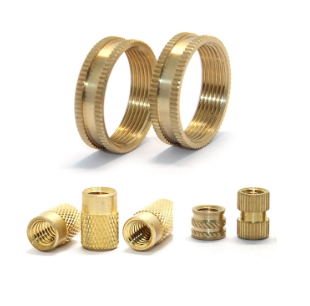Threaded Brass Inserts are a common mechanical component that is widely used in various industrial and manufacturing fields, especially in situations where enhanced thread strength and durability are required. They are usually made of brass Material, which has high strength, corrosion resistance, good machinability and Electrical conductivity. The following will introduce in detail the material, use, characteristics, advantages and why to choose threaded brass inserts.

Material:
Threaded brass inserts are mainly made of brass. Brass is an alloy composed of copper and zinc, usually containing small amounts of other elements (such as lead or tin) to improve its properties. The main characteristics of brass are good corrosion resistance, wear resistance and machinability. Its chemical composition and physical properties make it very ideal in many applications, especially when corrosion resistance, high strength and long-term durability are required.
Use:
Threaded brass inserts are widely used in situations where strong threaded connections are required in soft materials (such as aluminum, plastic, wood, etc.). They are commonly used in the following fields:
Electronic and Electrical equipment: The good conductivity of brass makes it a preferred connector material in electronic and electrical equipment. Threaded brass inserts are commonly used in circuit boards, connectors, and grounding systems.
Automotive Industry: In automotive manufacturing, threaded brass inserts are used in engines, body structures, and internal components to enhance the strength and durability of threaded connections, especially in high-pressure and high-temperature environments.
Aerospace: In the aerospace field, threaded brass inserts are used in the interior and exterior parts of aircraft to provide reliable connections, especially in environments with high vibration and temperature changes.
Furniture Manufacturing: In furniture manufacturing, threaded brass inserts are widely used in the assembly of wooden or plastic furniture to provide greater stability and durability by enhancing threaded connections.
Construction and Machinery: In construction and mechanical equipment, brass inserts are often used in metal parts that require strong threaded connections.
Features:
Threaded brass inserts have some significant features that make them important in various applications:
High strength and durability: Brass materials have excellent corrosion and wear resistance, allowing threaded brass inserts to maintain long-term performance stability in harsh working environments.
Good electrical conductivity: Brass has excellent electrical conductivity, which makes threaded brass inserts very important in electronic and electrical equipment.
Easy to process: Brass is a relatively soft material that is easy to process and form. Threaded brass inserts can be manufactured in a variety of ways, including turning, milling, drilling, and thread cutting.
Corrosion resistance: Brass has excellent corrosion resistance, especially when used in humid, salt water or chemical environments, which can effectively prevent rust and corrosion.
High temperature stability: Brass has good stability at high temperatures and is suitable for occasions where it is used for a long time in high temperature environments.
Advantages:
Threaded brass inserts have many advantages over inserts made of other materials:
Enhance thread strength: Threaded brass inserts can significantly enhance the strength of the connection by embedding the thread structure into the soft material, avoiding the difficulty of cutting threads directly in the soft material.
Prevent wear: Using threaded brass inserts can effectively reduce the wear that occurs during high-frequency tightening and loosening, thereby extending the service life of the components.
Simplify the production process: The use of threaded brass inserts reduces the need for more complex and precise thread cutting processes in manufacturing, improving production efficiency.
Improve connection reliability: The connection method using threaded brass inserts can maintain the stability of the connection during long-term use and avoid connection failure due to material fatigue.
Save costs: The processing cost of brass is relatively low, and by using threaded brass inserts, the overall product manufacturing cost can be reduced.
Why choose threaded brass inserts:
Material versatility: The versatility of brass makes threaded brass inserts suitable for a variety of working environments, from low temperature to high temperature, from conventional environment to extreme environment, and can perform well.
Improve the overall quality of the product: Threaded brass inserts improve the overall quality and durability of the product by strengthening the stability of the threaded connection, reducing failures and repairs caused by connection problems.
Optimize the production process: The use of threaded brass inserts can greatly optimize the production process. The processability of brass materials makes the manufacturing process simpler and more efficient, which helps to reduce production costs.
Improve the service life of equipment: Whether in the automotive, aviation or electronics Industries, the durability and stability of threaded brass inserts enable equipment to operate stably for a long time, reducing the frequency of maintenance and replacement.
Adapt to the needs of various industries: Whether in the electronics industry, automotive manufacturing or construction industry, threaded brass inserts can provide excellent solutions. They provide efficient and reliable connection methods in the needs of various industries.





 English
English

